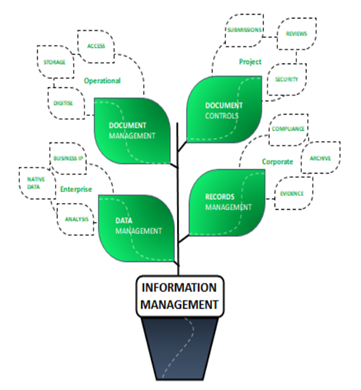I started my first role as a document controller eight years ago. Back then, when anyone asked me what I did for a job, I found myself needing to list out my job description for them to understand what it was I did each day.
Fast forward to today and the need for this level of detail is probably halved. These days, people are starting to catch on to the fact that anyone undertaking a role that involves the management of a business’ documents and records — and more holistically, data and information — can actually be pretty helpful and perhaps should earn more respect than just ‘paper pushers.’ (Warning: never ask anyone with the role of document manager, document controller or records manager to physically staple, bind, file or shred your document or record. It won’t end in a friendly cup of tea).
All organisations need to handle their paperwork. If they don’t, there will be more than a few loud unhappy voices from every corner. Those gripes could be anywhere between too much time wasted searching for something (if successful at all), poor quality content, poor decisions, incorrect applications, loss of productivity, high costs of rework and maybe even loss of reputation. Let’s be honest, we were all one of these voices once or twice, so we all know this pain, but looking at this list closely, if not addressed, they can serve some fairly hefty consequences. This is where document and records management fits into an organisational hierarchy, with the intent to reduce all these common pain points to improve the success of a business and its people.
Whilst companies will usually employ administrators of some sort who are absolutely worth their weight in gold, document and records management simply cannot be categorised in the same fashion as administrative work. The reason is because they play a part in managing a pair of little twins called data and information, of which their parents (the organisation) are extremely protective and controlling. Usually helicopter parenting invites some mum and dad shaming, but in this case, it is highly encouraged.
Data and Information
Data is possibly one of the most important elements to an organisation, perhaps second only to its people. Data is the facts and figures that are bound within different mediums (physical and digital) that hold key information about a company’s dealings and transactions. Data can be classified as structured (i.e., spreadsheets and databases) or unstructured (emails, images, text documents). In its native format, data will live only as data and serve no meaning until it is somehow organised, categorised, analysed and evaluated by a recipient which at that point evolves to the next most important thing to an organisation — information.
Let’s not forget here that information can be perceived differently depending on a whole range of reasons, so the information supplied to others needs to be clear, succinct and easy to understand, otherwise everyone gets to play a fun and time-consuming game of telephone where either data is not being organised correctly, and/or information is being misunderstood.
As organisations employ administrators, they will likely also employ data managers and information managers because they have their very own distinct focuses. Data managers facilitate the collection, usage and security of native business data, whilst information managers handle the collection of one or many sources of information and facilitate it being shared to particular audiences. So, in the case of document management and records management, as subsets of information management, whilst they both manage business data for the intent of being used as information, they do have a couple of very significant differences. It all depends on what exactly is being managed in regard to content (document management) or context (records management) and also that just slightly important thing called “evidence.”
Document Management
Document management focuses on the content of a document, i.e., the data or information, and making it available to those who need it, either by distribution or simple search and find, at the time it is needed for the purpose of an activity or process. To make it even more simple, it’s the classic who, what, where, when, why and how. Its objective is to digitise a company’s paper files for storage, categorisation, tracking and sharing to make it easier for employees, stakeholders and collaborators to locate and access required documents for improved productivity.
Document Control
To add to the puzzle, we can also consider document control, the bigger but younger, louder and faster cousin of document management. In addition to everything document management involves, it also manages document security, revision control, document quality, vigilant document dissemination and tracking, review and approval workflows and the eventual archive of necessary documentation.

Document control is often also in charge of managing other unstructured data that is conducted within a document management system, such as a Request for Information (RFI), that is needed for business processes, analysis and decision making. Another significant difference here is that is manages formal submissions to external parties, and therefore is usually applied to project environments.
Records Management
Records management conversely focuses on the context of a document such as its creation, receipt, storage, maintenance, archive and eventual disposal. This is more focused around the life cycle of a business’ valuable data and information. Most importantly though, an extraordinary significance is placed on the capturing and preserving of historical and compliance detail of the records so they may be used as evidence of business activities, processes and transactions.
Once this can be observed, it makes sense that not every document becomes a record and not every record will be a document. This seems like an easy distinction to make but to get this right every time is actually a refined and heavily practiced skill, especially since there might be a blinding price tag associated with the wrong action, hence why document and records managers take their careers so seriously.
An Essential and Successful Ecosystem
As we have discovered, document management and records management are two very different beasts, and in an ideal world they would coexist in harmony, so all our bases are covered. Sure, there may be some overlap, but you’ll find that subject matter experts in charge of these will make no bones about ensuring clear responsibilities. And so, whilst data and information are the building blocks to any business, document and records management are crucial to any resulting business prosperity.
They empower a workforce to do their jobs faster and more accurately, reduce risk of sensitive information leaking, obtain truthful and timely information about business activities and also save backsides if any legal conversations take a nasty turn. The benefits just speak for themselves.
If you think about it, it is seemingly effortless to access the information you need during the general workday, and there is a reason for that. It is because we — document managers, document controllers and records managers alike — make it our duty to ensure that it is. We actually care about making your job easier, and your successes bigger, by working alongside you and not against you.
And when it all goes according to plan, it means we have done a great job. When someone thanks you for that, it is one of the best feelings in the world, because we have worked hard for it. I know of so many who have told me that they could not imagine in a hundred years doing my job, but I actually couldn’t imagine doing anything else.
Ready to take a deeper dive? InEight can help get your projects where they need to go and help you create a solution that matches your needs whilst leveraging your teams’ existing strengths. Let us show you how.
Explore how InEight Document can streamline your document management processes and enhance project efficiency.





